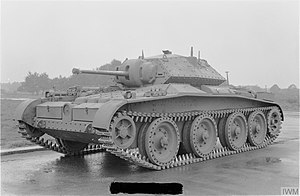Covenanter tank
| Tank, Cruiser, Mk V, Covenanter (A13 Mk III) | |
|---|---|
 | |
| Type | Cruiser tank |
| Place of origin | United Kingdom |
| Service history | |
| In service | 1940 - 1943 |
| Production history | |
| Designer | LMSR/Nuffield |
| No. built | 1,771 |
| Specifications | |
| Mass | 19 tonnes |
| Length | 19 ft (5.97 m) |
| Width | 8 ft 6 in (2.77 m) |
| Height | 7 ft 4 in (2.24 m) |
| Crew | 4 (commander, gunner, loader, driver) |
| Armour | 7–40 mm |
Main armament | QF 2-pounder |
Secondary armament | 7.92 mm Besa MG (coaxial) |
| Engine | Meadows Flat-12 D.A.V. 340 hp (250 kW) |
| Power/weight | 18 hp/ton |
| Transmission | Wilson compound epicycle gearbox |
| Suspension | Christie |
Operational range | 100 miles (160 km) |
| Maximum speed | 30 mph (50 km/h) |
The Tank, Cruiser, Mk V, Covenanter (A13 Mk III) was a British Cruiser tank of the Second World War. It was named for the Covenanters, a Scottish religious faction in the British Isles at the time of the Wars of the Three Kingdoms. The Covenanter was the first cruiser tank design to be given a name.
History
In 1938, the War Office had issued a requirement for a new, better armoured cruiser tank to replace the Cruiser IV. Nuffield's A16 design was found to be too expensive and in 1939 a cheaper A13 Mk III was adopted. London, Midland and Scottish Railway Company (LMSR) designed the hull, Nuffield - the turret and Henry Meadows - the engine. On April 17, before even a single prototype was produced, first 100 vehicles were ordered from the LMSR and soon additional orders followed, with English Electric and Leyland Motors joining the production effort, a total of 1,771 Covenanters were produced. Nuffield was also approached, but preferred to design its own offspring of the A13 line, which became the Cruiser Mk.VI Crusader.
In an attempt to keep the vehicle as low as possible, a low profile horizontally opposed engine was used. However, that left no room for radiators in the engine compartment. As a result, the radiators were moved to the front of the vehicle. The unusual arrangement, combined with rushed design process, resulted in serious problems with engine cooling. These problems meant that the Covenanter could not be employed in the North African Campaign. Instead, Crusader and American tanks were sent to Africa, while all 1,700 Covenanters produced remained in the British Isles.
By late 1943 the Covenanter was considered too weakly armed and armoured to deal with new German tanks. It was decided that neither problem could be addressed without significant changes in the design, so the tank was declared obsolete and all vehicles except the bridgelayer variant were scrapped.

Combat usage
Except for a few vehicles, Covenanters were never deployed outside of the British Isles. The British 1st Armoured Division was equipped initially with them, but when it was sent to Egypt, the tanks were transferred to the 9th Armoured Division. Eventually a handful of vehicles were sent to the desert for service trials. It is not clear if these tanks were ever used in combat. Covenanters were also issued to some Polish units formed in the UK; they were replaced before these units were sent to the frontline. The only Covenanter known to have been lost to enemy action was destroyed by a German air raid on May 31, 1942 in Canterbury.
A few bridgelayers were used by the Australian forces in the Pacific Campaign.
Variants
- Covenanter Mk I (Cruiser Mk V) - Original production model.
- Covenanter Mk I CS - Armed with 3-inch howitzer. CS stands for close support.
- Covenanter Mk II (Cruiser Mk V*) - Radiator-mounted oil cooler added.
- Covenanter Mk II CS - Armed with 3-inch howitzer.
- Observation post version existed with dummy gun, two No. 19 radios and No. 18 radio.
- Command version existed with dummy gun and two No. 19 radios.
- Covenanter Mk III (Cruiser Mk V**) - Twin oil coolers installed either side of the engine. Clutch linkage modified. Air cleaners added inboard at the rear. Exhaust silencers moved to the ends of the track guards.
- Covenanter Mk III CS - Armed with 3-inch howitzer.
- Covenanter Mk IV - As the Mk II with the clutch changes of the Mk III.
- Covenanter Mk IV CS - Armed with 3-inch howitzer.
- Observation post version existed with dummy gun, two No. 19 radios and No. 18 radio.

- Covenanter Bridgelayer - Covenanter hull fitted with a bridge 34' long and 9' 6" wide which could cover a gap 30' wide, capable of carrying 24 tons. In 1944 an improved bridge was developed with 30 tons capacity.
- Covenanter ARV Mk I - Armoured recovery vehicle based on turretless Covenanter hull. One prototype was built in 1942.
Additional equipment:
- Anti-Mine Roller Attachment (AMRA) Mk IC - a mine clearing device consisting of four heavy rollers suspended from a frame. Weight of the rollers could be increased by filling them with water, sand etc.
References
- David Fletcher, Peter Sarson - Crusader Cruiser Tank 1939-1945, 2000 Osprey Publishing (New Vanguard 14), ISBN 1-85532-512-8.
